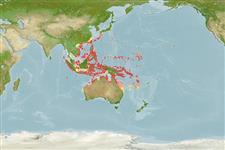Actinopterygii (ray-finned fishes) >
Perciformes (Perch-likes) >
Nemipteridae (Threadfin breams, Whiptail breams)
Etymology: Scolopsis: Greek, skolex = worm + Greek, opsis = appearance (Ref. 45335).
Environment / Climate / Range
Ecology
Marine; reef-associated; depth range 1 - 20 m (Ref. 9785). Tropical, preferred ?; 33°N - 27°S, 93°E - 172°E (Ref. 3810)
Eastern Indian Ocean and Western Pacific: throughout the southeastern Indian Ocean, including Cocos-Keeling Islands and northwestern Australia, and from the Ryukyu Islands to the Marshall Islands and Vanuatu. Record from the Andaman Islands is unconfirmed. Referred to as Scolopsis cancellatus by most authors.
Size / Weight / Age
Maturity: Lm ? range ? - ? cm
Max length : 25.0 cm TL male/unsexed; (Ref. 90102); common length : 13.0 cm SL male/unsexed; (Ref. 3810)
Dorsal
spines
(total): 10;
Dorsal
soft rays
(total): 9;
Anal
spines: 3;
Anal
soft rays: 7. Head scales reaching forward to or just in front of level of anterior margin of eye. Lower limb of preopercle naked. Antrorse (forward-directed) suborbital spine absent. Pelvic fins long, reaching beyond level of anus. Color: Upper body olive brown, silvery-white below. 3 yellowish white stripes along head and body. Juveniles white, with 3 black bands on upper half of body, interspace between lower pair of yellow bands; black spot between first three dorsal spines.
Common on coral reefs usually associated with sandy areas. Adults inhabit outer lagoon reef flats and seaward reefs flats, often in groups. Juveniles are found singly near the shelter of corals on clear shallow lagoon reefs (Ref. 9710). Adults form schools or small groups (Ref. 48635). Feeds on small fishes, crustaceans (Ref. 9710) and benthic invertebrates, primarily polychaetes (Ref. 37816).
Life cycle and mating behavior
Maturity | Reproduction | Spawning | Eggs | Fecundity | Larvae
Russell, B.C., 1990. FAO Species Catalogue. Vol. 12. Nemipterid fishes of the world. (Threadfin breams, whiptail breams, monocle breams, dwarf monocle breams, and coral breams). Family Nemipteridae. An annotated and illustrated catalogue of nemipterid species known to date. FAO Fish. Synop. 125(12):149p. Rome: FAO. (Ref. 3810)
IUCN Red List Status (Ref. 115185)
CITES (Ref. 94142)
Not Evaluated
Threat to humans
Harmless
Human uses
Fisheries: minor commercial; aquarium: commercial
More information
Common namesSynonymsMetabolismPredatorsEcotoxicologyReproductionMaturitySpawningFecundityEggsEgg development
ReferencesAquacultureAquaculture profileStrainsGeneticsAllele frequenciesHeritabilityDiseasesProcessingMass conversion
Tools
Special reports
Download XML
Internet sources
Estimates of some properties based on models
Phylogenetic diversity index (Ref.
82805): PD
50 = 0.5000 [Uniqueness, from 0.5 = low to 2.0 = high].
Bayesian length-weight: a=0.01905 (0.01036 - 0.03504), b=2.99 (2.83 - 3.15), in cm Total Length, based on LWR estimates for this species & Genus-body shape (Ref.
93245).
Trophic Level (Ref.
69278): 3.8 ±0.59 se; Based on food items.
Resilience (Ref.
69278): High, minimum population doubling time less than 15 months (K>1).
Vulnerability (Ref.
59153): Low vulnerability (13 of 100) .
